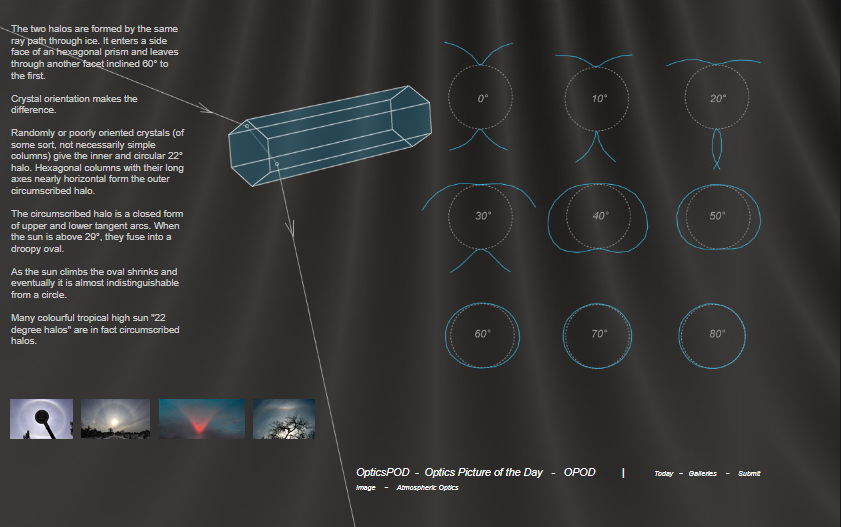OPOD - Circumscribed Halo
OPOD - Circumscribed Halo: A Phenomenon of Ice Crystals in the Atmosphere
The circumscribed halo is a captivating atmospheric optics phenomenon that occurs when sunlight interacts with ice crystals in the atmosphere. This unique optical display forms an oval-shaped halo surrounding the familiar 22° halo. Photographed by Peter O'Toole near Creeslough, Letterkenny, Co.Donegal, Ireland, this remarkable image showcases the beauty and intricacy of the circumscribed halo.
Both the 22° halo and the circumscribed halo are created by the same ray path through ice crystals. When sunlight enters a side face of a hexagonal prism and exits through another facet inclined at an angle of 60° to the first, these halos are formed. However, it is the orientation of the ice crystals that differentiates between the two.
- Randomly or poorly oriented crystals give rise to the inner and circular 22° halo.
- Hexagonal columns with their long axes nearly horizontal are responsible for the outer circumscribed halo.
The circumscribed halo can be thought of as a closed form of upper and lower tangent arcs. When the sun is positioned above 29°, these arcs merge together to form a droopy oval shape. As the sun ascends higher in the sky, the oval gradually shrinks until it becomes almost indistinguishable from a circle.
Interestingly, many vibrant and colorful "22 degree halos" observed in tropical regions under high sun conditions are actually circumscribed halos. This demonstrates how this optical phenomenon can manifest in different geographical locations, adding to the allure and diversity of atmospheric optics.
It is important to note that this article has been automatically converted from the old site and may not appear exactly as intended. The original article can be found here.
To summarize, the circumscribed halo is a captivating atmospheric optics phenomenon that forms an oval-shaped halo surrounding the 22° halo. It is created by the same ray path through ice crystals, with the orientation of the crystals determining whether a circular 22° halo or an outer circumscribed halo is formed. The circumscribed halo exhibits a unique droopy oval shape when the sun is above 29°, gradually shrinking as the sun climbs higher. This phenomenon is not limited to specific geographical regions and can be observed in tropical areas as well. The beauty and complexity of atmospheric optics continue to captivate and inspire us, reminding us of the wonders that exist right above our heads.

Circumscribed Halo
Peter O'Toole imaged this fine circumscribed halo from near Creeslough, Letterkenny, Co.Donegal, Ireland. The oval circumscribed halo surrounds a 22° halo and touches it above and below the sun.
©Peter O'Toole, shown with permission.

The two halos are formed by the same ray path through ice. It enters a side face of an hexagonal prism and leaves through another facet inclined 60° to the first.
Crystal orientation makes the difference.
Randomly or poorly oriented crystals (of some sort, not necessarily simple columns) give the inner and circular 22° halo. Hexagonal columns with their long axes nearly horizontal form the outer circumscribed halo.
The circumscribed halo is a closed form of upper and lower tangent arcs. When the sun is above 29°, they fuse into a droopy oval.
As the sun climbs the oval shrinks and eventually it is almost indistinguishable from a circle.
Many colourful tropical high sun "22 degree halos" are in fact circumscribed halos.
Note: this article has been automatically converted from the old site and may not appear as intended. You can find the original article here.
Reference Atmospheric Optics
If you use any of the definitions, information, or data presented on Atmospheric Optics, please copy the link or reference below to properly credit us as the reference source. Thank you!
-
<a href="https://atoptics.co.uk/blog/opod-circumscribed-halo-2/">OPOD - Circumscribed Halo</a>
-
"OPOD - Circumscribed Halo". Atmospheric Optics. Accessed on November 22, 2024. https://atoptics.co.uk/blog/opod-circumscribed-halo-2/.
-
"OPOD - Circumscribed Halo". Atmospheric Optics, https://atoptics.co.uk/blog/opod-circumscribed-halo-2/. Accessed 22 November, 2024
-
OPOD - Circumscribed Halo. Atmospheric Optics. Retrieved from https://atoptics.co.uk/blog/opod-circumscribed-halo-2/.